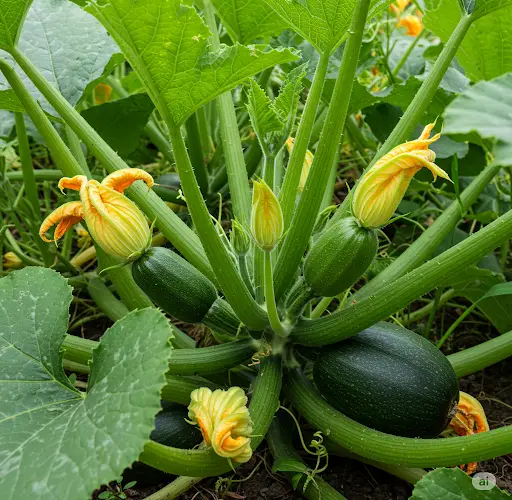Growing squash vertically is a smart gardening technique that not only saves space but also improves airflow, sun exposure, and fruit production. But there’s another, often overlooked benefit: effective pest control. By combining vertical growth with strategic pruning, gardeners can dramatically reduce the risk of pest infestations and disease—two of the biggest challenges in squash cultivation.
Here’s how pruning and vertical training work together to create a healthier, more productive squash patch.
Why Grow Squash Vertically?
Squash plants—especially vining varieties like zucchini, crookneck, and butternut—tend to sprawl across the garden, quickly taking up space and creating a dense, humid environment beneath their large leaves. This shaded, moist microclimate is the perfect habitat for pests like squash bugs, vine borers, aphids, and fungal infections like powdery mildew.
Vertical gardening lifts the plant off the ground and opens it up to more sunlight and airflow. Combined with regular pruning, this technique keeps plants tidy and far less appealing to common garden pests.
Common Pests That Affect Squash
Before diving into pruning techniques, it’s helpful to understand the pests you’re working to prevent:
-
Squash bugs: These pests suck sap from leaves, causing wilting and yellowing.
-
Squash vine borers: Larvae bore into stems, cutting off water and nutrient flow.
-
Aphids: Small insects that feed on plant sap and spread disease.
-
Cucumber beetles: Not only do they chew foliage, but they also transmit bacterial wilt.
-
Fungal diseases: Powdery mildew and leaf spot thrive in crowded, humid conditions.
Many of these problems can be drastically reduced by improving visibility and airflow through pruning.
How Pruning Helps Prevent Pest Problems
Pruning squash plants may seem counterintuitive—after all, more leaves mean more photosynthesis, right? While that’s true in part, excess foliage can actually work against you by:
-
Creating hiding places for pests
-
Reducing airflow, increasing humidity and fungal risk
-
Shading fruits, slowing ripening and increasing chances of rot
Pruning solves these issues by:
-
Exposing pests early so they can be removed
-
Allowing air to circulate freely through the plant
-
Directing energy to fruit production instead of excess foliage
Step-by-Step Guide to Pruning Vertical Squash
-
Start Early
Once your squash plant begins vining (typically after a few weeks of growth), begin training it up a strong trellis, stake, or vertical netting. As the vine grows, you can begin light pruning. -
Remove Lower Leaves
The leaves closest to the ground are the most prone to fungal disease and pest infestation. Trim them with clean garden scissors or pruners. Leave at least 1 foot of stem clear at the base. -
Snip Unnecessary Side Shoots
If your variety produces side vines or runners, consider removing some of them to keep the plant more upright and less bushy. This prevents overcrowding. -
Thin Dense Clusters of Leaves
If certain areas of the plant become overgrown, cut out a few large leaves to let light and air reach the interior. Don’t remove too many at once—just enough to open up airflow. -
Check for Pest Signs During Pruning
As you trim, inspect the undersides of leaves and along stems for eggs, larvae, or adult pests. Remove and dispose of any affected foliage. -
Use Clean Tools
Always sterilize your pruners before and after trimming to avoid spreading disease.
Additional Tips for Vertical Squash Success
-
Mulch below plants with straw or wood chips to prevent splashback of soil-borne pathogens.
-
Water at the base, not overhead, to keep leaves dry and discourage mildew.
-
Use natural deterrents, like neem oil or insecticidal soap, to handle small infestations early.
-
Hand-pollinate if needed. Vertical plants may attract fewer bees, so transferring pollen manually between flowers can boost fruit production.
-
Support developing fruits with slings or nets if they grow large—this prevents snapping or breaking off from the vine.
When to Stop Pruning
As the plant nears the end of its productive life or begins to slow down naturally in late summer, stop pruning to allow it to complete its lifecycle. At this stage, focus on monitoring for pests and harvesting mature fruits.
Final Thoughts
Vertical squash cultivation isn’t just a way to save space—it’s a practical pest-control strategy when paired with smart pruning. By removing lower and overcrowded leaves, exposing stems to light and air, and catching pest issues early, you can create a healthier plant environment that’s less attractive to common threats.
With a trellis, a sharp pair of shears, and a little attention each week, you’ll enjoy more squash and fewer pests throughout the season.



